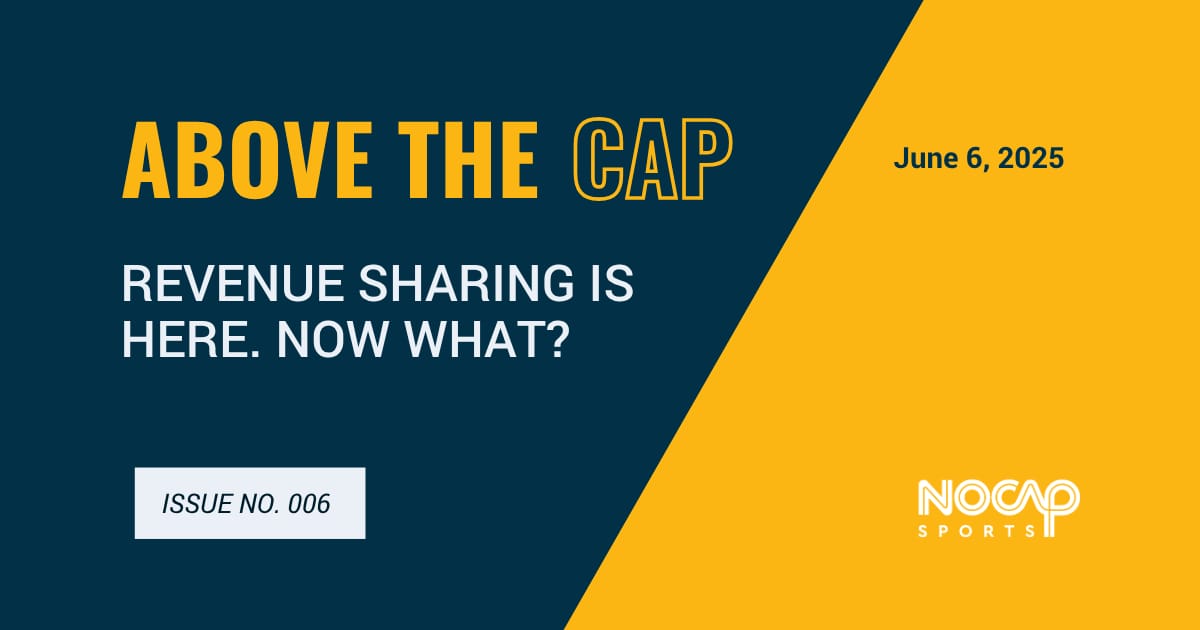- NOCAP Sports
- Posts
- Revenue Sharing Is Here. Now What?
Revenue Sharing Is Here. Now What?
Above the Cap | Issue 006 | June 2025

🚀 No Cap: Quick Take
It’s here. And it’s real.
On July 1, the revenue-sharing era begins, unlocking up to $20.5 million a year in athlete compensation. Roster caps, hard budgets, and new compliance pressures are rewriting the playbook. College sports are no longer just competitive; they’re big business. Every dollar matters. Every decision counts. Every deal must deliver results. The stakes have never been higher, and it’s all happening now. Let’s get into it.
🔍 The Fine Print: Policy. Rules. Impact
Direct Pay for College Athletes. Here’s What You Need to Know
If approved, the NCAA’s historic settlement in House v. NCAA will take effect on July 1, 2025. All we are waiting on now is the judge’s ruling, which is expected at any time. The settlement would give schools the green light to compensate athletes directly for the use of their name, image, and likeness in athletic programs. However, it’s being applied in actuality for their athletic ability while calling it “NIL”. With a $2.8B backpay fund and an annual $20.5M revenue-sharing cap per institution, the walls of amateurism are crumbling. The settlement will usher in a quasi-professional era with massive legal and financial implications, so expect more chaos after the settlement.
The NCAA, in partnership with the Power 4 conferences and Deloitte, has established a national clearinghouse tasked with enforcing “fair market value” and verifying the legitimacy of NIL deals beyond revenue-share disbursements. There is mixed reporting on whether this only applies to “Associated Entities" (i.e., collectives), but it appears that any deal over $600 could be flagged and potentially affect an athlete's eligibility. The question is, how is Fair Market Value (FMV) defined? And can that be legally enforced? The issue is that, without employee status and collective bargaining that includes athletes, as is the case in professional leagues, limiting an athlete's ability to earn compensation violates antitrust laws.
💡 Insight: If the House settlement is approved, all NIL agreements must have a “valid business purpose related to the promotion of goods or services.” NOCAP Sports can help collectives and brands that need assistance navigating these new rules or who want to understand the best legal avenues for paying their athletes above the salary cap. Reach out to [email protected] to learn more.
💰 The Ledger: Revenue. Relationships. Results
Roster Caps Are Coming. Here’s the Budget Reality
For the 2025–2026 season, traditional scholarship limits will be replaced by roster caps, forcing collectives and athletic departments to rethink compensation strategies, Title IX compliance, cap management, and revenue sources.
Programs like Texas are planning to offset budget increases by raising ticket prices. Texas A&M has already secured massive media rights deals to help stabilize NIL payouts. Meanwhile, schools like PItt are working to retain top talent by leveraging NOCAP Revenue Solutions ecosystem of strategic commercial partners to identify new revenue streams.
Without the necessary resourcing, you can expect a domino effect in college sports. If a Power 4 school underfunds its NIL program (rev-share), its top athletes may consider hitting the transfer portal. This means less competitive teams and the potential for the additional loss of revenue in donor funding and conference distributions. In this climate, competitive NIL is no longer a nice-to-have; it’s survival capital.
💡 Insight: Athletic departments and collectives will need additional revenue streams to offset donor fatigue, and MMR partnerships alone will not be enough. They’ll need to manage athletic talent like front offices manage professional teams, realigning NIL resources to account for ROI, Title IX risk, and athlete retention.
📣 Brand Playbook: Campaigns. Conversions. Athlete Influence
Story-Driven NIL Is the Most Impactful Strategy
As campaign budgets tighten, brands are shifting their focus toward structured activations that work smarter. Think: multichannel campaigns with verified reach, engagement metrics, and deliverables tied to real outcomes. That means less “partner splash,” more “partner synergy.”
Campaigns like Gatorade’s all-female basketball NIL roster and regionally targeted micro-influencer deals, such as the ones LinkedIn activated this spring, are thriving because they connect with seasonality and cultural relevance, delivering a measurable impact.
🔦 Spotlight: LinkedIn x Hunter Dickinson x NOCAP
Hunter Dickinson isn’t just an elite basketball player – he’s building a career beyond the court. His NIL collaboration with LinkedIn was part mentorship, part marketing—and it delivered both.
It’s a prime example of synergy in action.
📩 Subscribe Today
The college sports landscape continues to evolve. Are you ready for what comes next?
NOCAP Sports empowers athletes, brands, universities, and collectives with technology and services that will help expand earning potential, activate athlete partnerships at scale, and deliver sustainable revenue.